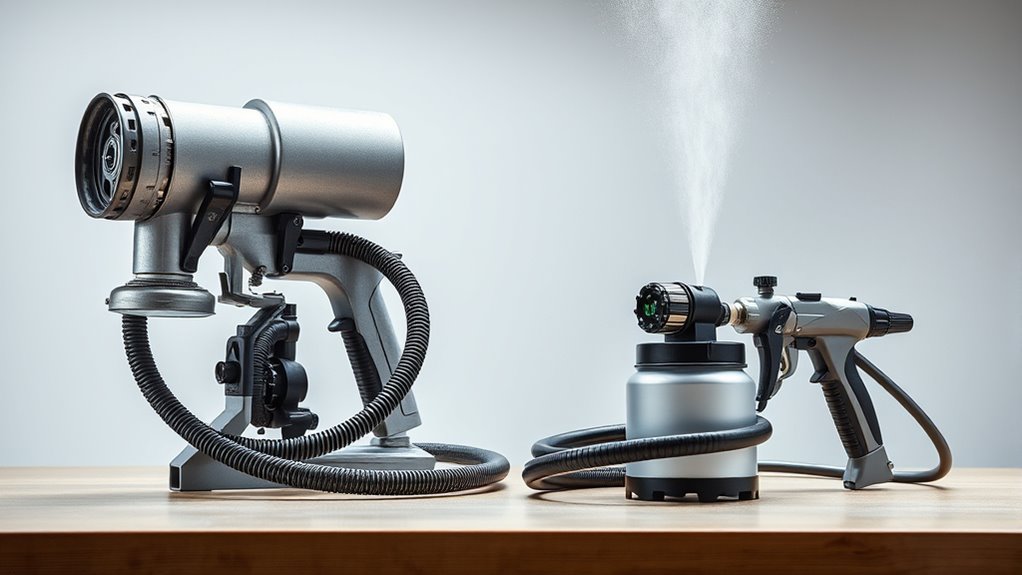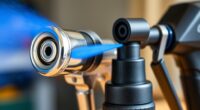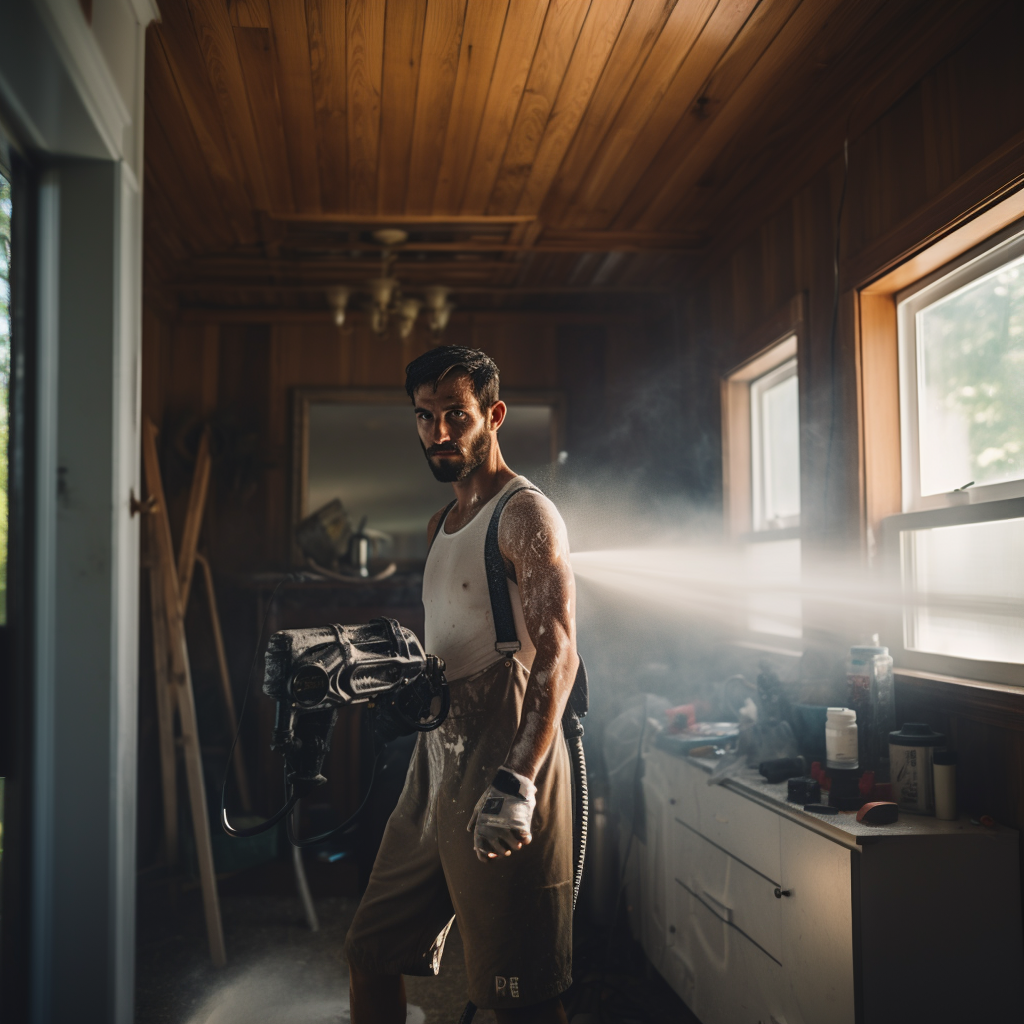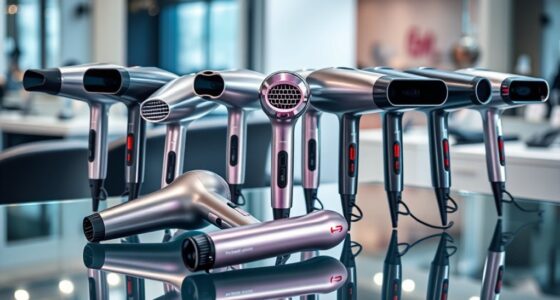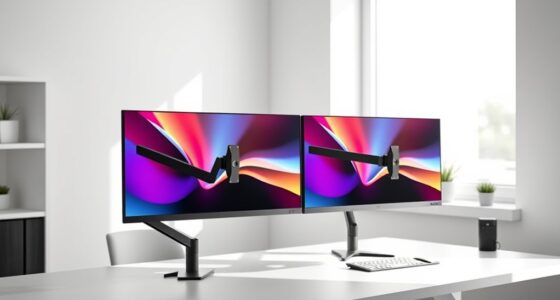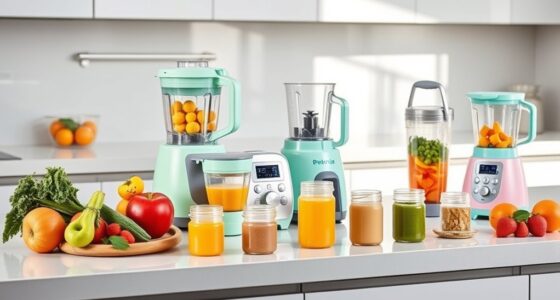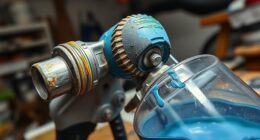Airless sprayers deliver high pressure for fast coverage and are best for large exterior projects involving thick paints or textured surfaces. HVLP sprayers use lower pressure, providing more control and a smoother finish, ideal for interior work, furniture, and detailed surfaces. Their main differences lie in power, spray pattern, and overspray. If you want to know which tool suits your specific project needs, keep exploring the key distinctions.
Key Takeaways
- Airless sprayers deliver higher pressure for fast coverage on large, textured surfaces, while HVLP offers precise control for detailed, smooth finishes.
- HVLP sprayers produce less overspray and are ideal for interior projects, furniture, and cabinetry; airless sprayers are better for exterior and high-viscosity paints.
- Airless units are typically more expensive, durable, and suitable for large-scale projects; HVLP sprayers are affordable, portable, and perfect for small, detailed work.
- HVLP provides finer atomization with a glossy, smooth finish; airless creates broader spray patterns that may result in a textured surface.
- HVLP is environmentally friendly with minimal overspray; airless sprayers can generate more waste and airborne paint particles.
How Airless and HVLP Sprayers Work

Both airless and HVLP sprayers rely on different mechanisms to atomize and deliver paint evenly onto surfaces. In airless sprayers, a high-pressure pump pushes paint through a small spray nozzle, creating a fine mist. The spray nozzle’s size and pressure determine the spray pattern and how well the paint atomizes. The pressure control in airless systems allows for rapid coverage, making them ideal for large projects. HVLP sprayers, on the other hand, use a turbine or compressor to generate a lower pressure, pushing paint through a spray nozzle that produces a softer, more controlled spray. The paint’s viscosity plays an essential role in both systems; thicker paints may need thinning to pass smoothly through the spray nozzle and guarantee even coverage. Proper technique and application methods are vital to achieve the best finish with each type of sprayer. Understanding these differences helps you choose the right sprayer based on your project’s needs. Additionally, sprayer maintenance is crucial to ensure consistent performance and prolong the lifespan of your equipment. Proper cleaning and regular checks of nozzle condition can significantly impact spray quality and efficiency. Regularly inspecting equipment components can help prevent common issues and maintain optimal operation.
Differences in Spray Pattern and Finish Quality
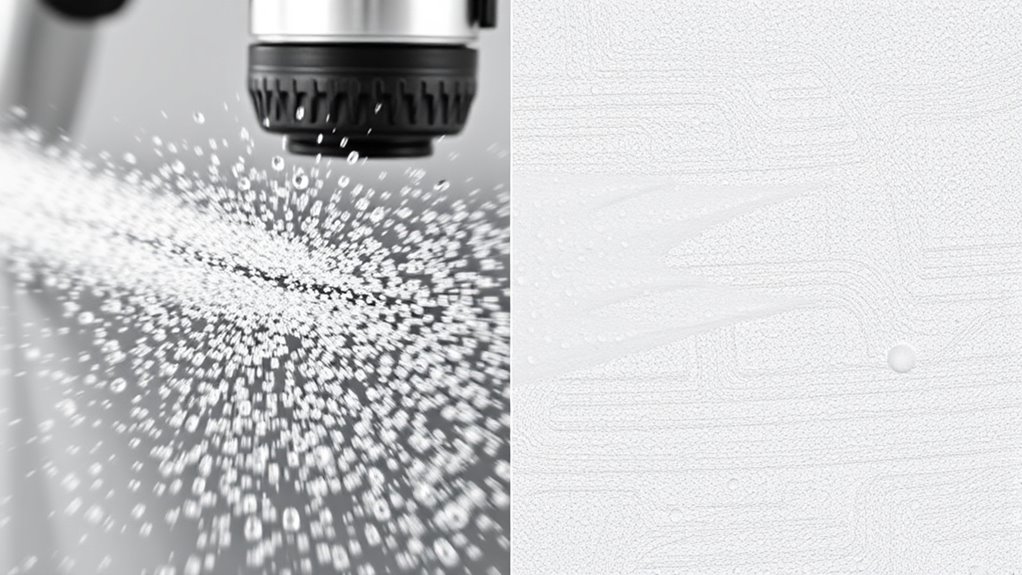
You’ll notice that airless and HVLP sprayers produce different spray patterns, affecting how precisely you can target surfaces. These differences influence the surface smoothness and the uniformity of your finish. Understanding how each tool handles these aspects helps you choose the best option for your project. Additionally, the type of sprayer used can impact the quality of the paint finish, making it essential to select the right tool for your specific needs. Incorporating spray pattern consistency into your application process ensures a more professional and high-quality result. Recognizing the application techniques required for each sprayer type also contributes to achieving a durable and visually appealing coating. Furthermore, considering tuning options for equipment can optimize spray performance and efficiency.
Spray Pattern Precision
When it comes to spray pattern precision, HVLP sprayers generally deliver a more consistent and controlled finish, thanks to their lower pressure and larger fluid tip. Their nozzle design allows for better control of the spray pattern, resulting in fewer overspray and drips. This precision makes it easier to achieve smooth, even coats, especially on detailed or delicate surfaces. In contrast, airless sprayers produce a less refined spray pattern due to higher pressure, which can lead to uneven coverage. If you need tight control over your finish and minimal overspray, HVLP’s nozzle design and consistent spray pattern give you an edge. Overall, for projects demanding accuracy and a polished look, HVLP sprayers excel in spray pattern precision. Additionally, the design of the spray nozzle in HVLP sprayers is optimized to reduce waste and improve finish quality. The pressure control inherent in HVLP systems further enhances their ability to produce a precise and uniform coating.
Surface Smoothness Variations
Surface smoothness varies considerably between airless and HVLP sprayers due to their differing spray patterns and atomization capabilities. With airless sprayers, the higher pressure often results in a more textured surface, which can reduce gloss level and create a less uniform surface texture. In contrast, HVLP sprayers produce a finer spray with better atomization, leading to a smoother finish and higher gloss level. The spray pattern of HVLP devices allows for more controlled application, minimizing surface imperfections and enhancing surface smoothness. If you want a sleek, reflective finish, HVLP sprayers are generally the better choice because they deliver an even coat with fewer texture inconsistencies. Conversely, airless sprayers may leave a slightly coarser surface but cover large areas quickly.
Finish Uniformity Consistency
The spray pattern and atomization quality directly influence the overall finish uniformity when using airless and HVLP sprayers. With airless efficiency, you get a broader spray pattern that covers large areas quickly but may produce less precise finishes. In contrast, HVLP offers hvlp precision, resulting in finer control and smoother, more consistent surfaces. Proper tip size selection is crucial, as it impacts spray pattern and finish quality, especially when aiming for detailed work. Key factors include: – Airless sprayers can create uneven textures if not carefully managed – HVLP sprayers deliver more uniform finishes due to better control – Airless efficiency is ideal for large, rough surfaces – HVLP ensures detailed, high-quality finishes on intricate projects. Additionally, understanding spray pattern consistency helps in choosing the appropriate tool for specific tasks, ensuring optimal results. Recognizing the importance of finish quality allows for better selection based on project requirements—speed versus precision—and understanding these differences helps you achieve the best results.
Ideal Applications for Each Type of Sprayer
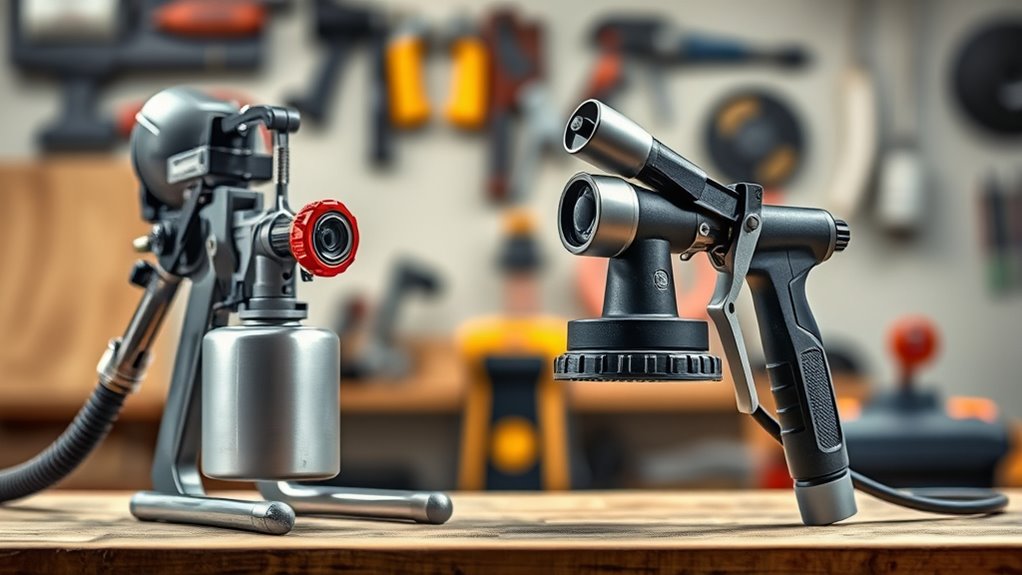
Choosing the right sprayer depends on the project’s specific needs. For large exterior surfaces like siding, decks, or fences, an airless sprayer is ideal because of its ability to handle high-viscosity paints and cover vast areas quickly. It’s perfect when surface compatibility involves thick or textured materials. On the other hand, HVLP sprayers excel with detailed work and interior surfaces, such as furniture or cabinetry, where precision and minimal overspray matter. They work best with lower-viscosity paints, providing a smooth finish on delicate surfaces. If you’re working on projects requiring fine control and a high-quality finish, HVLP is your go-to. For broad, quick coverage on tougher surfaces, an airless sprayer is the better choice. Additionally, understanding the material compatibility of each sprayer type can help ensure optimal results for your specific project. Being aware of spray pattern control can also improve the quality of your finished work. Proper technique and application are crucial for achieving professional-looking results with either type of sprayer. Furthermore, using the right sprayer can minimize overspray and waste, leading to cleaner workspaces and cost savings.
Power and Pressure Levels of Airless Vs HVLP Systems
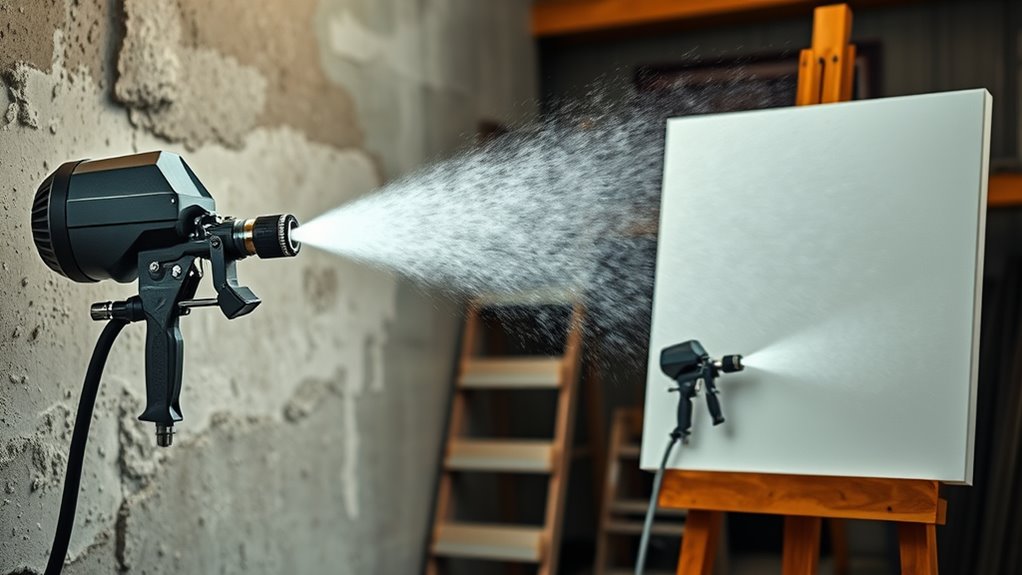
Understanding the power and pressure levels of airless and HVLP sprayers is essential for selecting the right tool for your project. Airless sprayers deliver high pressure levels, often between 1500 to 3000 PSI, providing maximum power output for large, thick coatings. In contrast, HVLP systems operate at lower pressure levels, typically around 0.1 to 1.0 PSI, focusing on precise control and minimal overspray. Additionally, the performance capabilities of each system influence their suitability for different applications. Key points include:
- Airless sprayers generate higher pressure levels for faster coverage.
- HVLP sprayers have lower pressure, ideal for detailed work.
- Power output in airless models is markedly greater.
- HVLP systems prioritize reduced overspray over raw power.
- Selecting the appropriate system depends on your aesthetic goals and project requirements.
Furthermore, understanding pressure regulation helps ensure optimal results and efficiency during your painting tasks. Proper pressure adjustment is crucial to achieving a smooth finish and avoiding issues like paint splatter or uneven coating. For example, knowing that airless sprayers can handle thick coatings makes them suitable for large-scale exterior projects, while HVLP systems excel at fine finishes on furniture or cabinetry.
Ease of Use and Setup Considerations
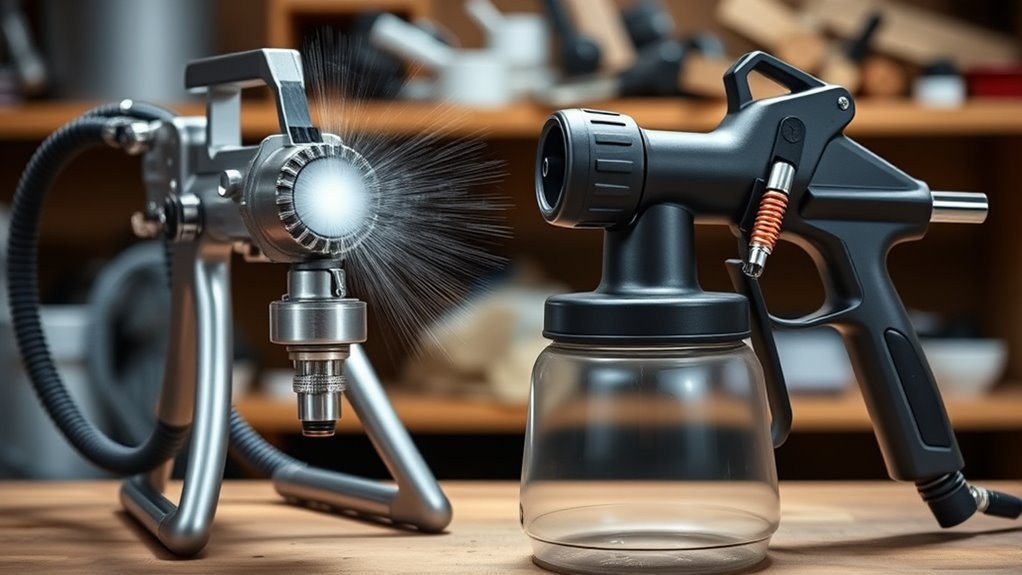
When evaluating ease of use and setup, consider how quickly you can get the sprayer ready and how straightforward the process is. Airless sprayers often have larger, less ergonomic designs, which can make them harder to handle for extended periods. HVLP systems tend to be more portable, with better ergonomics, allowing you to move around comfortably. Noise levels also factor in: airless sprayers are typically louder, which might require hearing protection and add fatigue. HVLP units usually operate more quietly, making them easier to use in enclosed spaces or residential settings. Overall, HVLP sprayers offer a simpler setup process, especially if portability and comfort are priorities. These factors can markedly impact your workflow and overall experience during projects.
Cost and Maintenance Factors
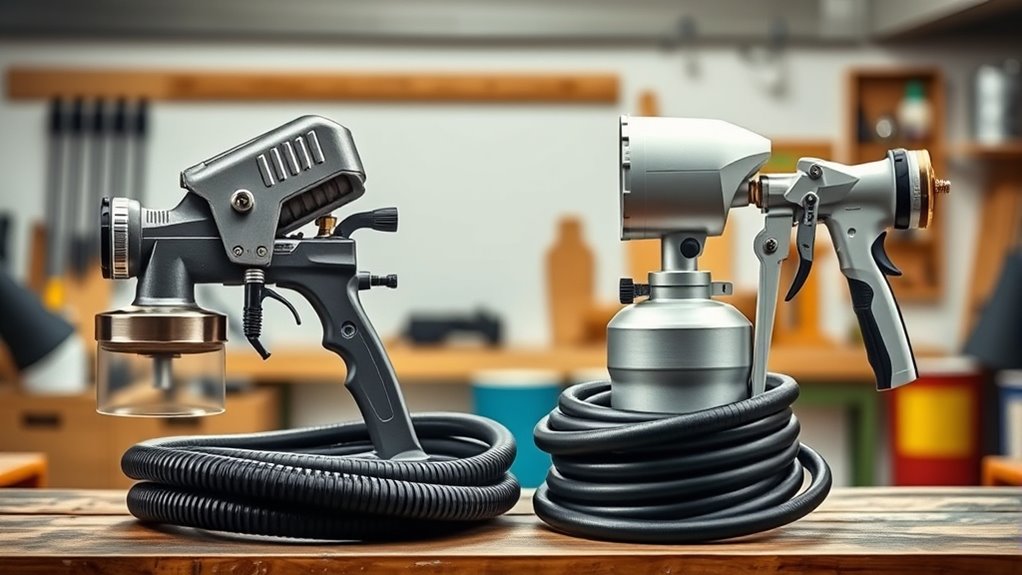
When comparing airless and HVLP paint sprayers, you’ll want to contemplate the initial equipment costs and ongoing maintenance expenses. Some models may be cheaper upfront but cost more to keep in good shape over time. Ultimately, evaluating the long-term investment helps you choose the best option for your projects and budget.
Equipment Cost Comparison
While upfront costs vary between airless and HVLP paint sprayers, considering long-term expenses is essential for making an informed decision. Airless sprayers tend to be more expensive initially but handle thicker paint viscosity better, reducing the need for thinning. HVLP systems are usually more affordable upfront but may require more frequent replacements or repairs. Keep in mind, noise level can also impact costs, as louder models may need soundproofing or special accommodations. Additionally, the cost of accessories, filters, and maintenance supplies can add up over time.
- Higher initial investment for airless sprayers
- Lower purchase price for HVLP units
- Potential for increased repair costs with HVLP
- Noise level considerations impacting ongoing expenses
Maintenance Expenses Overview
Maintenance expenses for airless and HVLP sprayers can considerably impact your overall costs, as each system requires different levels of care and parts replacement. Airless sprayers often need frequent filter maintenance to prevent clogs, and compressor costs can add up if you use a separate air compressor. HVLP units generally have fewer filters and less compressor dependency, reducing ongoing expenses. Here’s a quick comparison:
| Aspect | Airless Sprayers | HVLP Sprayers |
|---|---|---|
| Filter Maintenance | Regular cleaning, replacement needed | Less frequent, simpler upkeep |
| Compressor Costs | Usually require external compressors | Often integrated, no extra cost |
| Overall Expenses | Higher due to parts and upkeep | Lower maintenance costs |
Understanding these factors helps you budget better for long-term use.
Long-term Investment Value
Evaluating the long-term investment value of airless and HVLP paint sprayers requires weighing initial costs against ongoing expenses. While airless sprayers typically have higher upfront prices, they’re often more durable and suitable for large projects, making them a solid choice for professional tools in the paint industry. HVLP sprayers usually cost less initially but may require more frequent maintenance or parts replacement over time. Consider these factors:
- Durability and build quality
- Frequency of use and project size
- Cost of replacements and repairs
- Efficiency and paint waste reduction
Your decision impacts not just immediate costs but also how well the sprayer performs over years of use, affecting your overall investment in professional tools within the paint industry.
Environmental Impact and Overspray Control
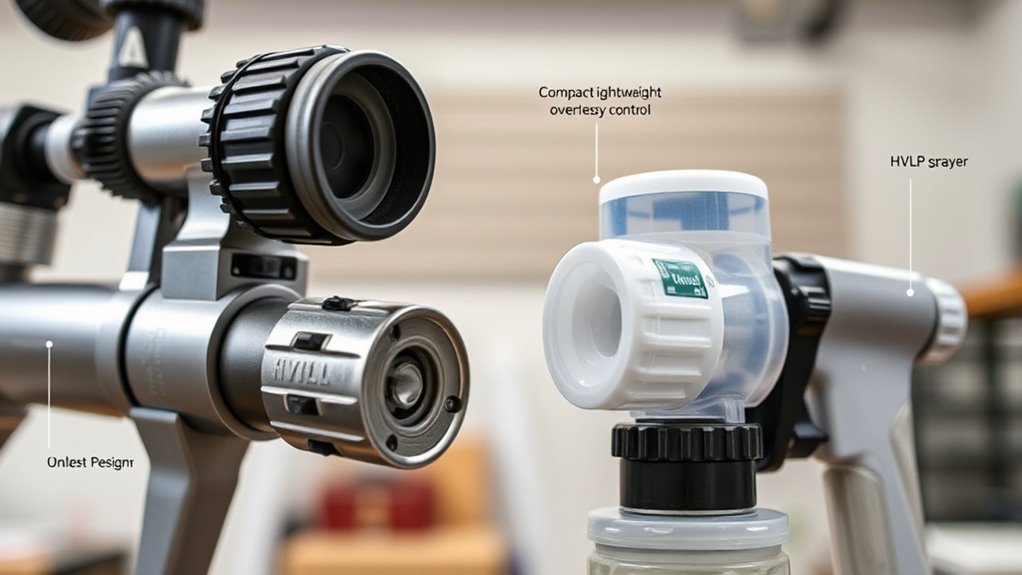
When it comes to environmental impact and overspray control, choosing the right paint sprayer makes a significant difference. HVLP sprayers are known for their eco-friendly practices because they produce less overspray, reducing spray waste and limiting airborne paint particles. This means you’ll use less paint overall, which minimizes environmental harm and saves you money. Airless sprayers, while efficient for large jobs, tend to generate more overspray, leading to increased waste and potential air pollution. By selecting a sprayer with good overspray control, you support spray waste reduction and a cleaner work environment. Your choice impacts not just your project’s quality, but also the environment, making it essential to weigh these factors carefully.
Making the Right Choice for Your Project
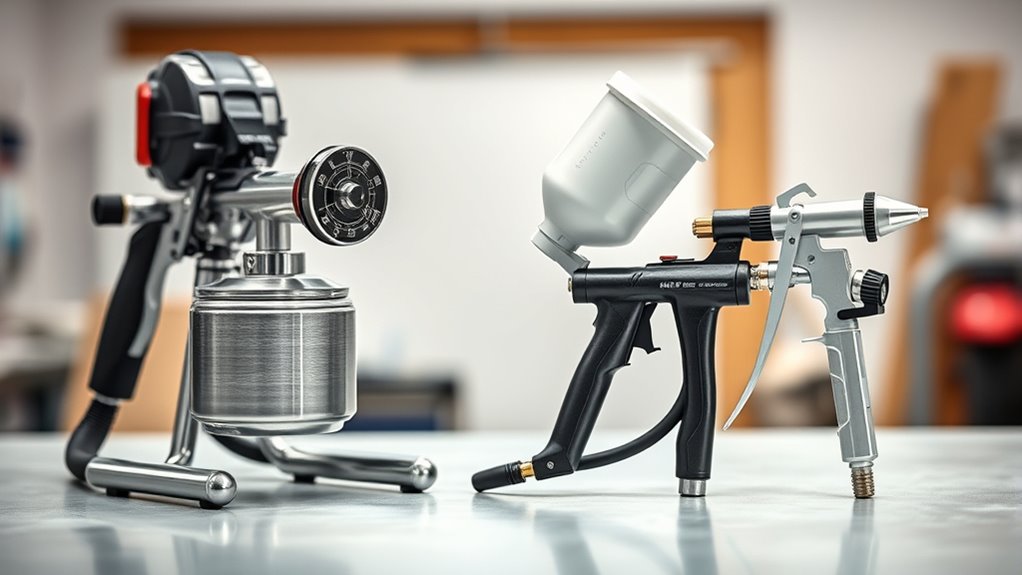
Choosing the right paint sprayer depends on your project’s specific needs, including its size, complexity, and desired finish. To make an informed decision, focus on choosing equipment suited to your task and guarantee paint compatibility. Consider these factors:
- The type of surface you’re painting, which influences spray pattern and equipment choice
- The viscosity of your paint to determine if it’s compatible with airless or HVLP sprayers
- The level of detail or finish quality needed, affecting spray precision
- Your project’s size, as larger jobs may benefit from faster airless sprayers, while smaller projects suit HVLP
Frequently Asked Questions
Which Sprayer Is Better for Detailed, Intricate Painting Projects?
For detailed, intricate painting projects, you’ll want a sprayer that offers precision control and detailed finishing. HVLP sprayers excel here because they produce a fine, controlled spray that minimizes overspray and allows you to work on delicate areas with accuracy. Airless sprayers, while powerful, tend to be better for large surfaces. So, for fine detail work, an HVLP sprayer is your best choice to achieve smooth, precise results.
How Does Paint Thickness Affect Sprayer Performance?
Did you know that paint viscosity can vary by over 50% depending on the brand? When it comes to spray consistency, thicker paint with high viscosity challenges sprayers, especially HVLP models, leading to uneven application. Properly adjusting your sprayer or thinning the paint improves performance, ensuring smooth, even coats. Monitoring paint viscosity helps maintain ideal spray performance and prevents clogs, making your project easier and more professional-looking.
Can Airless Sprayers Be Used Indoors Safely?
You can use airless sprayers indoors, but you need to prioritize safety. Guarantee proper indoor ventilation to reduce paint odor and improve air quality. Use masks and protective gear, and consider working in well-ventilated areas or using exhaust fans. While airless sprayers are powerful, taking these precautions helps prevent health issues and ensures a safer painting experience indoors.
What Safety Equipment Is Recommended for Each Sprayer Type?
While safety gear is vital for all spraying projects, the type varies. For airless sprayers, you should wear protective gear like masks, goggles, and gloves, and guarantee proper ventilation to handle overspray and fumes. With HVLP sprayers, lightweight masks and eye protection suffice, but good ventilation remains essential. Always follow manufacturer guidelines, prioritize protective gear, and maintain adequate ventilation to guarantee safe, effective use of either sprayer type.
Are There Environmental Certifications for Eco-Friendly Spray Systems?
You might wonder if eco-friendly spray systems have environmental certifications. Many eco certifications and green labels, like Green Seal or EPA Safer Choice, verify that these systems meet strict environmental standards. When choosing a spray system, look for these certifications to guarantee you’re selecting products that minimize environmental impact. These labels help you identify equipment designed with sustainability in mind, making your painting projects more eco-friendly and safer for the environment.
Conclusion
Choosing between airless and HVLP sprayers can feel like steering a maze, but understanding their differences helps you make the perfect pick. Whether you need the unstoppable power of an airless sprayer or the precision of HVLP, selecting the right tool can transform your project from ordinary to extraordinary. Remember, the right sprayer isn’t just a good choice—it’s your secret weapon for achieving flawless finishes that will leave everyone in awe.
Franz came aboard the Paint Sprayer Zone team with a background in both journalism and home renovation. His articulate writing style, combined with a passion for DIY projects, makes him an invaluable asset. Franz has a knack for breaking down technical jargon into easy-to-understand content, ensuring that even the most novice of readers can grasp the complexities of paint sprayers.
